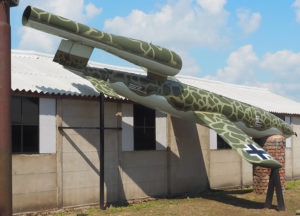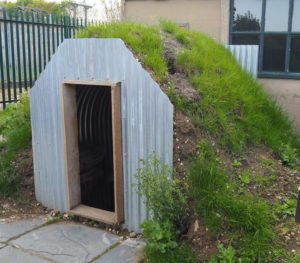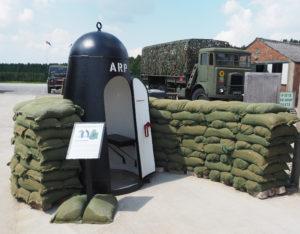You can’t miss Eden Camp with its display of army vehicles and fighter planes clearly visible from the road.
As well as exhibits in the different huts, there are examples of army vehicles, tanks and guns on display around the site .
There is also a Doodlebug V1 rocket or Buzz bomb, which really is massive and must have been a terrifying sight.The petrol burning engine produced a jet of flaming exhaust gas from the tail pipe and had a very distinctive throbbing noise. It was either launched from fixed ramps across the channel or from modified bomber aircraft. It was guided by an automatic pilot. The fuel cut off at a predetermined range, the noise stopped and the doodlebug plummeted to earth causing untold damage. 6725 were launched and a third fell on London, killing over 6000 people and injuring nearly 18,000.
Anti aircraft guns succeeded in shooting down 1859 between June 1944 and March 1945. Raf fighter planes succeeded in downing another 1771. Pilots had to fire at 180m and had to fly through the centre of the fireball. Another trick was to fly alongside and use their wing tip to nudge the doodlebug. This upset its guidance system and sent it crashing to earth.
There are examples of bomb cases around the site and the RAF Bomb Disposal Memorial, a reminder of how dangerous this job was.
There are examples of the different air raid shelters in use to protect the civilian population. Trench shelters were dug in parks, brick and concrete shelters in the streets and everyone had a gas mask.
Families with their own garden had an Anderson Shelter. These cost £7, although if you earned less than £5 a week, one was provided free. This was a small tunnel affair made of corrugated iron and covered with soil. This helped improve shock resistance as well providing extra space to grow vegetables.
In densely populated cities where families didn’t have a garden, “Morrison shelters”:https://tinyurl.com/4p49s6ap were provided. These were a low steel cage that could be used in the home and gave more protection. than hiding under the stairs.
There is also an example of an ARP Fire watch shelter. This came from a chemical factory near Edinburgh, and was on the roof of a three story building. Employees were rostered to carry out fire watching duties overnight and at weekends as well as their normal duties. They served along side the Auxiliary Fire Service and had to watch out for incendiary bombs being dropped and report them to the nearest ARP/Fire Control HQ, using telephone.
The shelter gave protection against the elements but more important would not be damaged by bombs falling on it.
The watchers received a “Purple” telephoned warning before the air raid siren sounded. Most incendiary bombs dropped by the Germans would cause serious fires if left unchecked. The watchers might tackle small fires themselves, but their main job was to ensure the Fire Brigade could gain access into buildings where incendiaries had smashed or burnt their way into.










